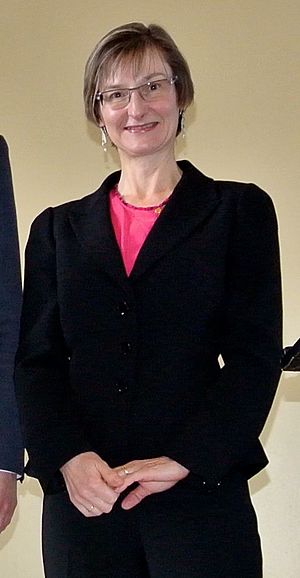Muffy Calder facts for kids
Quick facts for kids
Muffy Calder
|
|
|---|---|

Calder at the University of St Andrews in 2013
|
|
| Born |
Muffy Thomas
21 May 1958 |
| Alma mater | University of Stirling (BSc) University of St Andrews (PhD) |
| Known for | feature interaction problem Chief Scientific Advisor for Scotland |
| Spouse(s) | David James Calder (1998-present) |
| Awards | FRSE (2000) FIEE (2002) FBCS (2002) OBE (2011) FREng (2013) DSc (2024) |
| Scientific career | |
| Fields | formal methods |
| Institutions | University of Glasgow University of Stirling University of St Andrews University of Edinburgh |
| Thesis | The imperative implementation of algebraic data types (1988) |
| Doctoral advisor | Roy Dyckhoff |
Dame Muffy Calder is a brilliant computer scientist from Canada who now lives in Britain. She was born Muffy Thomas on May 21, 1958. She works at the University of Glasgow as a professor and helps lead the College of Science and Engineering. From 2012 to 2015, she was also the Chief Scientific Advisor for the Scottish Government. This means she gave important science advice to the government.
Contents
Biography
Her Early Life and Education
Muffy Calder was born in Shawinigan, Quebec, Canada. She studied computer science at the University of Stirling and earned her first degree (BSc). Later, she completed her PhD in computational science at the University of St Andrews in 1987. Her PhD supervisor was Roy Dyckhoff. Before she married David Calder in 1998, she published many important papers using her birth name, Thomas.
Her Career Highlights
Muffy Calder started working at the University of Glasgow in 1988. She was the Dean of Research for the College of Science and Engineering until 2012. On March 1, 2012, she became the Chief Scientific Adviser to the Scottish Government. This was a very important role where she advised leaders on science topics.
Before this, she also led important committees. She was the Chair of the UK Computing Research Committee. She also chaired the British Computer Society Academy of Computing Research Committee. In 2015, she became the Vice-Principal and Head of the College of Science and Engineering at the University of Glasgow. That same year, she joined the Council of the Engineering and Physical Sciences Research Council.
What She Studies
Muffy Calder's research focuses on "mathematical modelling and automated reasoning." This means she uses math and computers to understand how complex systems work. She studies systems that communicate and work at the same time.
She wrote a very important paper about the "feature interaction problem." This problem happens when different parts of a system try to do their jobs, but they get in each other's way. For example, if you have call waiting on your phone and also call forwarding, they might not work well together. Her work helps solve these kinds of problems.
Her research also helps in bioinformatics. She uses computer science methods to study how living things work. This includes looking at biochemical networks and how cells send signals to each other. Her work helps us understand complex biology better.
Awards and Special Honors
Muffy Calder has received many special honors for her work. In 2011, she was appointed an Officer of the Order of the British Empire (OBE). This award is given for great service to a field. She received it for her contributions to computer science.
In 2020, she received an even higher honor. She was appointed a Dame Commander of the Order of the British Empire (DBE). This award is for major contributions to research and education. It means she is now called "Dame Muffy Calder."
She is also a member of several important groups of experts:
- The Royal Society of Edinburgh (since 2000)
- The British Computer Society (since 2002)
- The Institution of Electrical Engineers (since 2002)
- The Royal Academy of Engineering (since 2013)
These fellowships mean she is recognized as a leading expert in her field. In June 2024, the University of St Andrews gave her a special Doctor of Science (DSc) degree. This was to celebrate her amazing work in computer science and her help to the wider science community. In 2012, The Herald newspaper listed her as the 21st most influential woman in Scotland.

